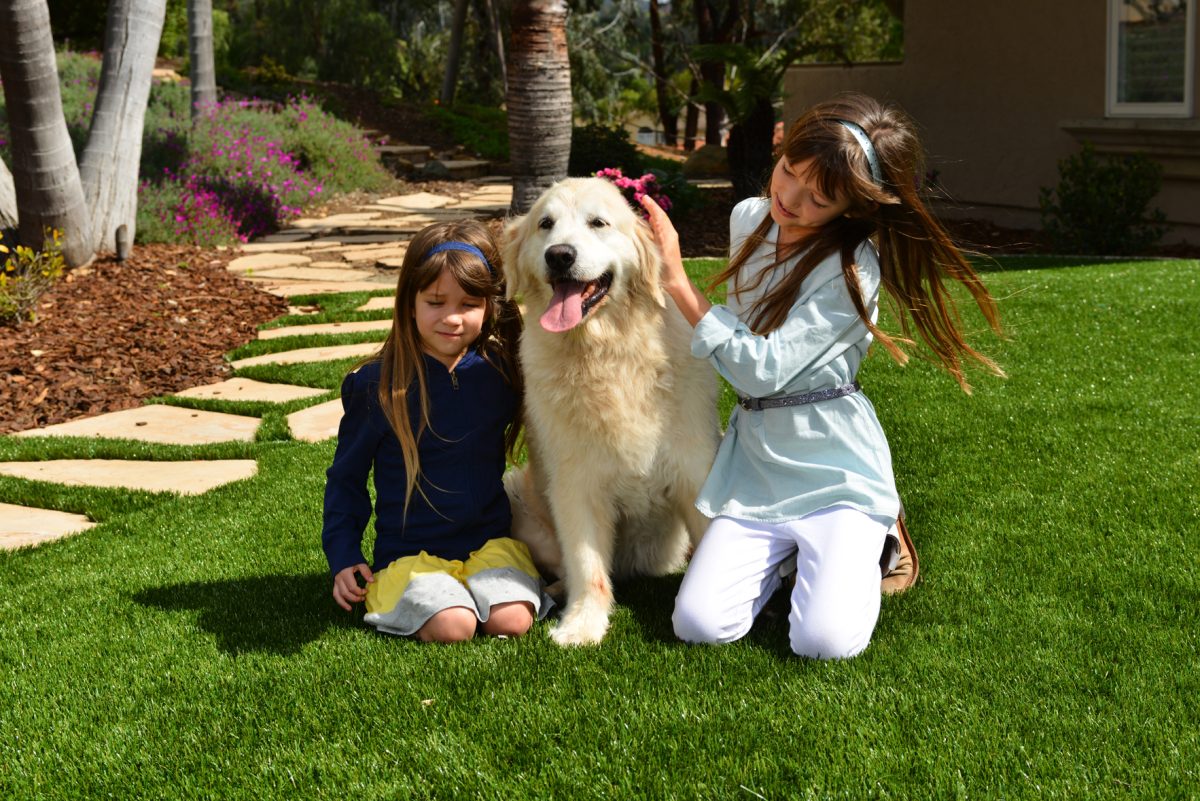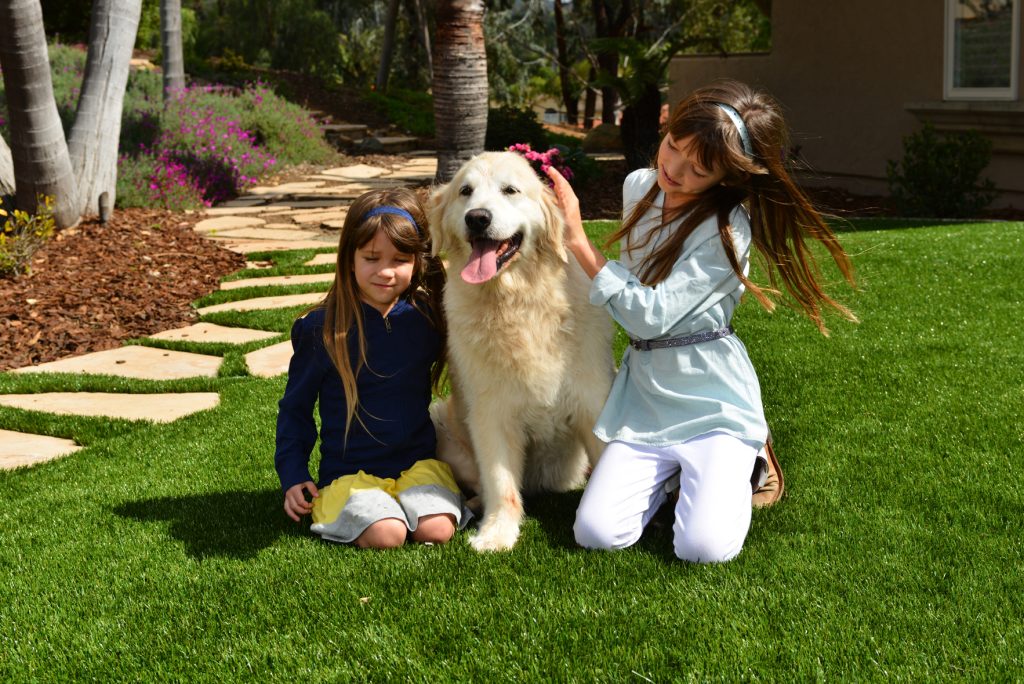- BACKYARD
- COMMERCIAL
- ENVIRONMENT
- FIELD TURF NEWS
- GOLF
- MAINTENANCE
- NEWS
- PETS
- POOL
- RESIDENTIAL
- TURF TIPS
How Artificial Grass Helps Manage Allergies


Seasonal allergies are incredibly common and incredibly irritating! Natural sod grass is among the most common allergens and does not discriminate as far as age or species.
Instead of choosing to live in an isolated bubble, homeowners all over have decided to take advantage of artificial grass. Before we delve into how synthetic turf provides allergy relief, let’s explore the dangers of this health condition.
How Can Natural Lawns Trigger Allergies?
Natural grass can cause problems for people with pollen and mold allergies.
Pollen Allergies
Grasses produce flowers that release pollen grains into the air during warmer months. Pollen is very light and spreads easily via wind. When inhaled, grass pollen triggers allergic reaction to grass like sneezing, runny nose, and itchy eyes in sensitive people.
Mowing also kicks up and disperses grass pollen into the air. Cutting the grass can increase pollen levels, so frequent mowing means constant pollen exposure during pollination season.
On top of that, fertilizers, herbicides, insecticides, and other lawn chemicals contain irritants that can worsen allergy symptoms. Those with chemical sensitivities may experience headaches, rashes, nausea, and asthma flare-ups.
Mold Allergies
Damp, shady areas of natural lawns promote mold growth. Mold spores become airborne and can be inhaled, provoking allergy symptoms in sensitive people. They can cause congestion, sneezing, coughing, and irritated eyes.
Rotting grass clippings also provide an ideal environment for molds to thrive. Letting them remain on the lawn increases mold spore production.
How Dangerous Are Pollen Allergies?
Pollen allergies are nothing to scoff at, as they can give way to various health problems.
Respiratory Issues
Inhaling airborne grass pollen irritates the mucous membranes of the eyes, nose, throat, and lungs. Common allergy symptoms include repeated sneezing, coughing, runny nose, sinus congestion, and red, itchy eyes.
Some people experience wheezing, shortness of breath, chest tightness, and asthma attacks when exposed to grass pollen. Severe pollen allergies can restrict breathing and require emergency care. Staying indoors with windows closed may help reduce exposure during peak pollen seasons.
Anaphylaxis
In rare cases, some individuals have a life-threatening anaphylactic reaction to grass pollen. Anaphylaxis causes the throat to swell, restricting air flow. Other symptoms include dizziness, slurred speech, nausea, vomiting, hives, low blood pressure, and loss of consciousness.
Fatigue and Headaches
Chronic allergy symptoms like stuffy nose, sinus pressure, sneezing fits, and itchy eyes disrupt sleep quality and cause persistent daytime fatigue.
Dealing with ongoing allergy symptoms often triggers tension headaches. The mental and physical strain of unrelenting allergies can greatly diminish the quality of life. Over-the-counter pain relievers can temporarily alleviate headaches.
Diagnosing Grass Pollen Allergy
If allergy symptoms occur or worsen after exposure to grass, an allergy test can confirm grass pollen as the trigger. Skin prick testing exposes the skin to a small amount of grass pollen allergen. Blood tests measure antibodies produced in response to grass pollen.
Treating Grass Pollen Allergy
Treatment options for grass pollen allergy depend on symptom severity. Antihistamine nasal sprays and oral medications can relieve runny nose and itchy eyes.
Allergy shots build tolerance over time but require regular injections. For severe allergic rhinitis, immunotherapy tablets taken daily may be an option. Avoiding grass and taking precautions during pollen season also helps minimize exposure to allergens.
How Does Artificial Grass Prevent Allergy Problems?
Installing artificial grass offers several advantages for people and pets with grass allergies.
Eliminating Pollen Production
Natural grass produces pollen grains during warmer months that trigger allergic reactions when inhaled. Artificial grass blades do not flower or release pollen into the air. Without pollen production, it helps reduce allergy symptoms.
While some pollen from nearby live plants may still blow into the area, eliminating the pollen source from your own lawn provides significant relief. Kids and pets can play outdoors with less risk of allergy issues.
Avoiding Pollen Dispersal
Mowing and trimming natural grass stirs up and disperses pollen grains into the air, increasing exposure. With artificial turf, there is no mowing or trimming needed, preventing pollen disturbances.
Artificial lawns also don’t require fertilizers, herbicides, or pesticides which can contain chemicals that further irritate those with allergies. The lack of lawn treatments avoids contact with potential skin and respiratory irritants.
Discouraging Mold Growth
Natural grass lawns collect moisture, especially in shaded areas, promoting mold growth. Mold spores become airborne and can trigger allergy symptoms when inhaled.
Artificial grass drains well and dries quickly after rain and irrigation. With no organic matter, artificial lawns do not provide the ideal place for mold growth. Minimal mold production means lower exposure to airborne spores.
Synthetic turf is easy to clean and affordable to maintain. Those sacrificed Saturday mornings are a thing of the past, as of course, your artificial grass won’t need to be mowed, sprinkled with new sod, or fertilized. You can count on your turf to look great all year round.
Pets Can Develop Grass Allergies Too
Pet owners should be aware that dogs can also suffer from grass allergies. Natural grass exposure can cause skin and respiratory issues for sensitive animals. Artificial lawns provide a safer outdoor space for allergic pets.
Common Signs of Grass Allergies in Pets
Here are some of the symptoms of grass allergy in dogs.
- Rashes – Allergic skin reactions often manifest as red, inflamed patches, hives, and excessive itching or licking. Hair loss and weeping eyes may also indicate environmental allergies. These symptoms usually develop on the belly, feet, ears, muzzle, and other areas directly contacting allergens.
- Respiratory Distress – Allergic pets may cough, wheeze, sneeze, and have runny noses and watery eyes. Their noses and throats may become swollen and irritated. Difficulty breathing, especially when outdoors, can signal airborne allergies.
- Gastrointestinal Issues – Some pets experience nausea, vomiting, diarrhea, and other problems during allergy flare-ups. These signs are less common but should prompt veterinary attention.
- Ear Infections – Allergic irritation and inflammation can lead to secondary bacterial or yeast infections of the ears. Pets may scratch their ears excessively.
How Does Artificial Grass Provide Allergy Relief for Pets?
Artificial grass eliminates the pollen and mold production that aggravates pet allergies. The turf materials themselves are hypoallergenic and pet-safe. Plus, with no mowing or lawn chemicals, artificial grass avoids stirring up and spreading grass allergens and irritants.
Easy-to-clean synthetic fibers don’t trap allergens like dust and dander. Rinsing the lawn regularly helps keep allergens away.
Pets with grass allergies are free to play and lounge on artificial lawns without allergy attacks. Their quality of life improves greatly outdoors.
In short, an artificial grass lawn allows pets that are allergic to grass to enjoy the yard without suffering allergy symptoms. It’s an ideal solution for dogs with sensitivity to natural grass.
Ready to make the switch? Get in touch with one of our experts at FieldTurf Landscape today!


